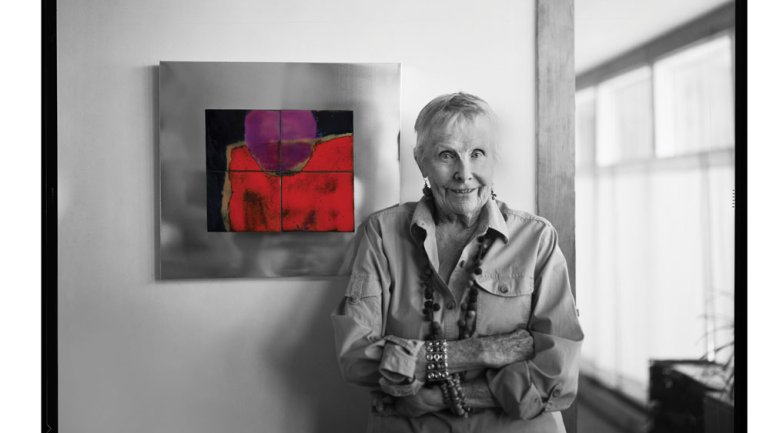Fired Up
Fired Up
For Harriet Johns, the combination of enamel, fire, and metal is the perfect vehicle for her expressive, instinctive works.
It's easy to imagine the response Harriet Johns got when she walked into a manufacturing plant in the early 1970s and described what she intended to create using the facility's equipment: large-scale art. There she was, a small woman in a very male, industrial environment where enamel-on-steel highway signs were produced.
"When you come in and you're 5-foot-3, and a woman, you need a little salesmanship," Johns relates with a sly smile. "When you tell them you want to create panels for a 40-foot wall, they have a few questions." As it turned out, a determined personality and hair-trigger sense of humor - which still define the artist at age 87 - helped get Johns in the door and plant workers on her side.
What ultimately went into the large, high-fire kilns were heavy steel panels, generally 4 feet by 3 feet, covered with abstracted designs in ground porcelain enamel, which melted and fused like glass onto the steel. What came out were bold paintings whose vitreous surfaces glow with saturated colors that never lose their radiance, indoors or out.
For decades Johns was commissioned to create her brash pieces for private and corporate collections, including a multipanel piece with intensely hued circuit-board imagery that covered a curved, 60-foot wall at IBM's Silicon Valley research lab. She doesn't make the big pieces anymore. Age has made that too challenging, not to mention her distance from an enamel plant - in the 1990s she settled in the remote foothills town of Crestone in southern Colorado. But Johns is also known for intimate pieces as small as a few inches square. Glenn Green, owner of Glenn Green Galleries + Sculpture Garden in Santa Fe, New Mexico, says he was struck by Johns' innovative use of fired enamel from his first glimpse of her work. "I had never seen it elevated to this artistic level," he says.
Making art on a large scale began early for Johns, who grew up in the North Dakota prairie town of Valley City, population 5,200. The daughter of classically trained musicians, and a violinist herself in her younger years, Johns was the beneficiary of a strong school system in a town that was home to a teacher's college. Her second-grade teacher recognized her talent and provided her with an easel and large canvases. Johns was 10 when she painted a 10-foot-long mural on a library wall.
After high school, Johns studied art in the Los Angeles area, then moved to northern California. Living in San Francisco in the 1960s and '70s and working as a contemporary art gallery director, she was immersed in the vibrant West Coast art scene. She also spent many years as a designer and builder for residential remodeling projects for San Francisco-based architects.
"I'm 50 percent architect. Guess I'm gonna have to decide what I want to be when I grow up," the artist jokes, sitting in the comfortable home she created from a railroad boxcar, which she had moved to Crestone. With a solar addition on the south side for light and warmth, the cozy, well-organized space reflects Johns' passion for color: The kitchen walls are bright blue, and the wood floor of the guestroom is painted a deep orange-red.
Color, in fact, is the element that drew Johns to enamel. In 1970 she was visiting an artist friend in Oregon who made small-scale enamel work and fired it in a potter's kiln. After learning the process, Johns "dove into it, and everything else disappeared. It's such a wonderful medium; it's just magical," she declares. "It's very concrete art."
Ground enamel can be mixed with water and sprayed onto a surface, but Johns prefers to sprinkle it onto steel in powder form. Varying the thickness of enamel and occasionally adding residue from tanks of acid she came across in enamel plants created texture and transformed the surface. Yet it is the unpredictable, alchemical nature of enamel and fire that determines its final colors, creating an element of serendipity that works well with the artist's own intuitive approach to design.
A lifelong traveler and reader with an insatiable appetite for ideas, Johns draws inspiration for her imagery from architecture, landscape, pre-Columbian textiles and artifacts, mythology, and her own experience with the animal world. A bear broke into her Crestone house - twice - leaving claw marks on her kitchen wall. She wasn't home either time, fortunately, but from these near-encounters came a series of works featuring abstract, iconic bear images.
In a journal entry, Johns writes of being drawn down her artistic path by "the glowing colors, always the unexpected combinations," and a "desire to capture the essence beneath the forms ... All life's experiences, journeys, sights, sounds, smells," she muses, "create a continuing vocabulary of images which I am compelled to record."
Harriet Johns is represented by Glenn Green Galleries + Sculpture Garden in Santa Fe, New Mexico. A 2009 monograph, H Johns: Colors From the Heart, is available through westerneyepress.com.
Gussie Fauntleroy is a Colorado-based writer who contributes regularly to national and regional publications on art, architecture, and design. She is the author of three books on visual artists.

